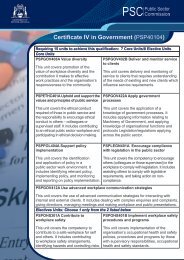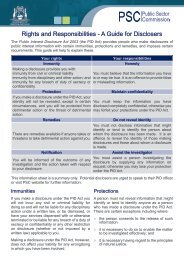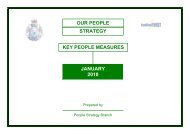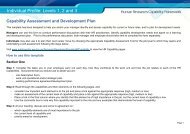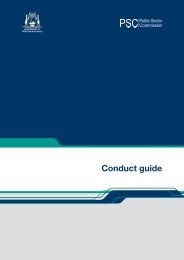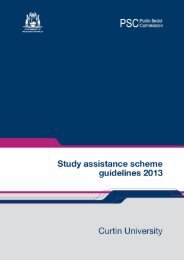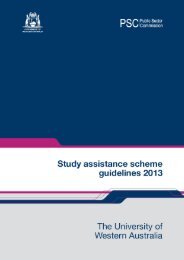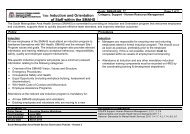Archived document - Public Sector Commission - The Western ...
Archived document - Public Sector Commission - The Western ...
Archived document - Public Sector Commission - The Western ...
Create successful ePaper yourself
Turn your PDF publications into a flip-book with our unique Google optimized e-Paper software.
e-Government Strategy for the <strong>Western</strong> Australian <strong>Public</strong> <strong>Sector</strong><br />
Effecting Change: <strong>The</strong> Key Enablers of e-Government<br />
34<br />
3. Governance Mechanisms<br />
As agencies become more interconnected, and the distinction between<br />
government and non-government service delivery becomes less obvious,<br />
there will be new challenges for public sector governance. Our current<br />
system of government is supported by legislation and regulations that<br />
segment information and services between Federal, State and Local<br />
Governments and often at agency level. e-Government will challenge<br />
these existing rules and regulations. A robust governance framework<br />
is required to support transformation to an integrated service<br />
delivery model.<br />
Each year agencies spend significant resources on major infrastructure<br />
and services. Good e-government information management practices<br />
enable the aggregation of data across agencies so as to facilitate a better<br />
whole-of-government understanding of how these resources are being<br />
procured and deployed, thereby increasing the overall transparency and<br />
accountability of government.<br />
Implementing collaborative multi-agency projects would deliver significant<br />
benefits to agencies and the community. However, in the present public<br />
sector environment there are many governance issues to consider:<br />
• Which agency or agencies will pay the initial and ongoing charges to<br />
maintain the e-government initiative<br />
• How will the costs be recouped<br />
• Who will have the responsibility for managing the infrastructure<br />
and services<br />
• Will this add to their costs without fully compensating for the<br />
extra workload<br />
• How will intellectual property issues be managed<br />
• What affect will this have on suppliers to government<br />
• Where does accountability reside<br />
<strong>The</strong> Role of OeG<br />
OeG is working to identify areas where the implementation of e-<br />
government initiatives would be impeded by a lack of adequate<br />
governance mechanisms and options for cross-government service<br />
delivery. Where possible, OeG will work with agencies to develop flexible<br />
collaboration frameworks to deal with these issues.<br />
As highlighted by the questions above, funding for e-government projects<br />
is going to be a significant governance issue when trying to initiate,<br />
develop and subsequently maintain cross-agency initiatives. OeG is<br />
collaborating with the Department of Treasury and Finance to address<br />
issues such as the initial point of funding for collaborative projects, joint<br />
agency funding bids and ongoing project responsibility.




